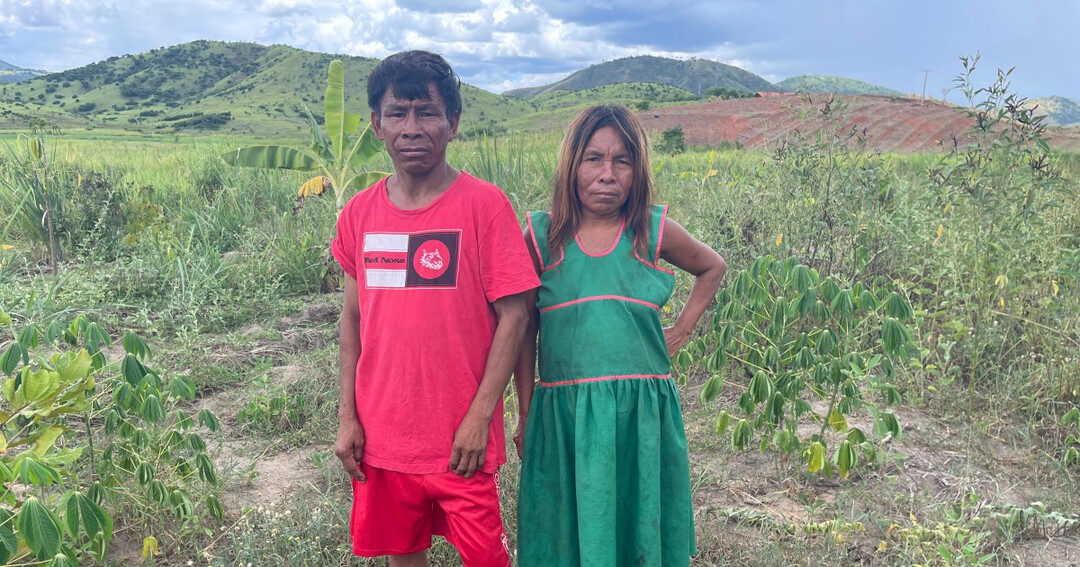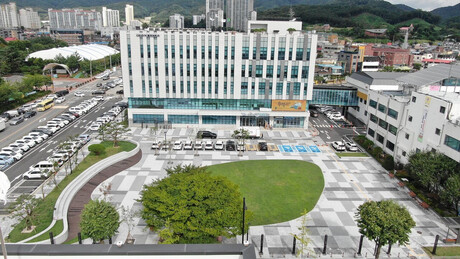
Brumadinho, Brazil – Brazil’s hottest region is blanketed by dense, invasive, and highly flammable Guinea grass. Blackened scars checker the rolling hills, evidence of fires that have increased with rising temperatures.
But entering the village of Prajnho reveals a patchwork of green. Here, amidst the parched plains, thrive coveted banana palms, cassava plants, and guava trees.
This verdant land is the result of Hāmhi Terra Viva (Hāmhi Living Land), an Indigenous-led agroecology project in eastern Brazil’s Minas Gerais state that weaves ancestral songs and traditions into the planting process.
These oases of trees, grown in backyard gardens or larger reforestation plots, represent a kind of regeneration for the local Maxakali people, also known as the Tikmũ’ũn.
The Atlantic Forest, which once covered the Maxakali’s ancestral lands, was a complex ecosystem of rainforest, coastal hardwood forests, and mangrove forests. Its dense canopy trapped moisture, fostering one of the most biodiverse regions in the world.
But the destruction of the Atlantic Forest has exacerbated local climate change impacts, contributing to increased fire risk.
Brazil’s Jequitinhonha Valley, home to the Maxakali’s four territories, has experienced a sharp rise in temperatures in recent years.
According to an analysis of 2023 Brazilian government data by the newspaper O Globo, 18 of the 20 cities in Brazil that recorded daily maximum temperatures 5°C above the average were located in the Jequitinhonha Valley.
The city of Araçuaí, in particular, broke the previous record for the highest temperature ever recorded in Brazil in November of that year, reaching 44.8°C. The city is located just 130 kilometers from Maxakali territory.
“We are at the epicenter of the climate crisis in Brazil,” said Rosângela Pereira de Tugny, coordinator of the Hāmhi project.
As practices like agriculture, development, and logging have encroached upon the forest, more than 85% of the Atlantic Forest has been destroyed. In Minas Gerais state, experts estimate that less than 8% of the forest remains.
“When I was a child, there was a lot of forest,” recalled Lúcio Flávio Maxakali, a school teacher and master’s student at the Federal University of Minas Gerais. “There were many animals, and we planted food like corn, beans, and sugarcane in the middle of the forest.”
But for centuries, colonizing settlers used fire to clear vast swaths of the Atlantic Forest. Farmers often sowed seeds of Guinea grass, brought from Africa, in the burned areas to feed cattle.
“The farmers changed the landscape,” said Manuel Damásio Maxakali, a 52-year-old leader in the Prajnho village.
With wrinkled hands, Damásio drew an impromptu map in the dusty soil, trying earnestly to explain the destruction wrought by the farmers. “They burned everything. They put up fences and brought in cattle. They cut down everything. Each time, the farmers took more land.”
Brazil’s military dictatorship, which lasted from 1964 to 1985, further catalyzed the destruction of the region’s tropical forests.
Under the motto “Integrating to not surrender,” the military leaders built roads through the dense forests and pushed development projects in remote areas to spur economic growth.
Ultimately, deforestation peaked between 1995 and 2004, with up to 27,772 square kilometers of forest destroyed per year.
Stooping to draw in the dirt, Damásio Maxakali illustrates how the environment has changed.
The result has been rising temperatures nationwide. In the Atlantic Forest region specifically, studies have shown that for every quarter of the forest that disappears, the surface temperature rises by 1°C.
If the entire forest were to be destroyed, temperatures could soar by up to 4°C, according to the research.
Without the humid forest cover, experts say that Maxakali territory has become hotter and drier. This increases the likelihood of wildfires.
Last year, the number of fires in Minas Gerais state broke records. In less than nine months, 24,475 fires were recorded, far surpassing the previous record for the entire year of 2021.
A lack of rainfall also contributes to the fire risk, and the seemingly endless Guinea grass creates a thick layer of flammable material across the landscape.
Guinea grass fires can spread four times faster than wildfires, leading the Maxakali to call the invasive plant “kerosene.”
Some fires are also started accidentally within Maxakali communities.
Eventually, fire is commonly used in Maxakali funeral rituals, where the deceased’s clothes, tools, and house are burned, and it is also used to clear land for cooking or to ward off snakes.
But wildfires are not the only consequence of the changing climate. The river in the Prajnho village has dried up so much that residents can no longer bathe in it.
“There is no water. The water dried up,” explained Damásio. “We used to use the river, but now there is nothing.”
Songs as Ecological Blueprints
A small hut sits perched on the arid, fire-scarred hillside in Brazil’s Minas Gerais state.
The Maxakali’s territory once spanned at least three large valleys of the Atlantic Forest. Village elders recall that the forest not only provided food, medicine, and building materials but also served as the habitat for yãmĩyxop, spiritual entities central to the Maxakali’s belief system.
“The forest had medicine for us,” explained Damásio. “When our bellies hurt, we used the bark of a tree, and it would get better. But now there is only grass. The farmers burned everything.”
But the four remaining protected areas of Maxakali land, reduced to 6,434 hectares of pasture, contain less than 17% of their original vegetation. Some experts consider the Atlantic Forest locally extinct.
Because of this absence, many Maxakali leaders are turning to reforestation, finding ecological blueprints of the past in their musical traditions.
Damasio Maxakali holds up a banana tree trunk amid the lush vegetation of the Hāmhi project.
Songs organize life in Maxakali villages. Music, for example, is used to cure illnesses, teach history, or transmit practical instructions, such as how to make bags or weave fishing nets.
“The songs tie the entire Tikmũ’ũn social structure together,” said de Tugny, the Hāmhi project coordinator and a musicologist at the Federal University of Minas Gerais. “People don’t compose songs; they have songs.”
She added that having a song means being able to care for the spirit considered the song’s creator.
Ancestral songs also provide extremely detailed records of the local ecology. The 12 musical canons, which vary in grammar and vocabulary, total about 360 hours of music. The lyrics are filled with hundreds of species of flora and fauna that are now extinct in their territory.
“We sing about everything: seedlings, bananas, ourselves,” explained Manuel Kelé, a leader in the Água Boa village. “Within our religion, even the dog has a song.”
One song, for example, lists 33 species of bees, some of which have no Portuguese name, Brazil’s common language, and only two of which exist in the territory today. The lyrics provide information about the bees’ behavior that many Maxakali have never witnessed firsthand.
“The songs are like snapshots,” said de Tugny. “Snapshots of all the details that existed in the Atlantic Forest: the names of insects, birds, plants, moments of the relationship between an animal and a leaf. All of this is recorded.”
For the Maxakali, ritualized singing plays a vital role in helping the forest regenerate. Songs are part of the daily work in Hāmhi’s tree nursery.
Nursery workers not only sing when planting seeds but also play music as part of the regular rhythm of harvesting and cultivation. The workers divide into groups, positioning themselves around the nursery and singing in harmony with one another. The song lyrics help participants recall ancestral ecological knowledge.
While some of Hāmhi’s work is dedicated to planting fruit trees and other crops, project leaders believe that reforestation is key to reducing fire risk in the region.
Since its inception in 2023, the Hāmhi project has planted more than 60 hectares of fruit trees and 155 hectares of Atlantic Forest vegetation. The goal is to reforest nearly double that area.
Program participants have also organized a temporary fire brigade and used traditional methods of planting fire-resistant plant species to create natural firebreaks.
“The songs help the forest grow,” said Damásio, the village leader. “We ask the dead to help us. They walk here and help us. We are calling for the forest to grow again.”
[Copyright (c) Global Economic Times. All Rights Reserved.]





























